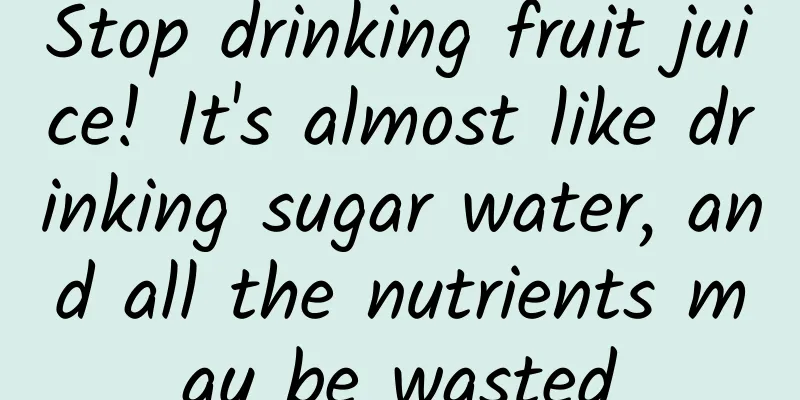Stop drinking fruit juice! It's almost like drinking sugar water, and all the nutrients may be wasted

|
In the eyes of many people, fruits are nutritious and healthy, and fruit juice squeezed into juice is the concentrated essence. But you may not know that when fruits are turned into juice, the calories soar and the nutrients are lost. Today, let's explore the truth behind freshly squeezed juice. Fruit juice A lot of nutrients will be lost! Many people think that there is not much difference between drinking freshly squeezed juice and eating fruit, but in fact, there is a huge difference in the nutritional essence between the two. Compared with eating the whole fruit, squeezing the fruit into juice wastes the essence and many nutrients are destroyed. 1 Increased sugar content After the fruit is squeezed into juice, the sugar in it is concentrated, resulting in a higher sugar content. Take apple juice as an example. The sugar content of a glass of freshly squeezed apple juice may even exceed that of a can of cola . If you don't believe it, take a look↓ Data source: Nutritional composition table of NFC 100% pure juice on e-commerce platform 2 Dietary fiber loss In the process of juicing, almost all the dietary fiber in the fruit is discarded. Dietary fiber can increase satiety and promote intestinal peristalsis, and plays an important role in preventing and relieving constipation, promoting digestion, and controlling weight. Although fruits contain sugar, the World Health Organization does not include fruits in its definition of free sugars in the "Guidelines for Sugar Intake for Adults and Children". This is mainly because ingredients such as dietary fiber can "offset" the negative effects of sugar in fruits. However , after becoming juice, the dietary fiber is lacking and the problem of sugar in the fruit becomes prominent. Fruit juice (including freshly squeezed pure fruit juice) is also listed as a member of free sugars. Image source: World Health Organization's "Guidelines for Sugar Intake for Adults and Children" 3 Loss of antioxidants such as vitamin C Vitamin C, β-carotene, and polyphenol antioxidants in fruits will also be lost during the juicing process. This is because during the juicing process, the fruits are chopped and stirred, and antioxidants such as vitamin C are fully exposed to oxygen in the air, causing oxidation reactions, which reduces the content of vitamin C and polyphenols. Taking vitamin C as an example, according to experimental data, the vitamin C in freshly squeezed cucumber, mango and orange juice was measured respectively, and it was found that the loss rates were 84.11%, 58.92% and 32.76% respectively, which should not be underestimated. Drinking too much juice It’s really unhealthy for your body! The increase in sugar content and the loss of key ingredients such as VC and dietary fiber are only the nutritional changes when fruits are blended into juice. In fact, these changes can also lead to differences in the health effects. 1 Sugar is more easily absorbed, and blood sugar rises faster After the fruit is turned into juice, the properties of the sugar itself also change, from endogenous sugar to free sugar, which becomes easier to be absorbed by the human body . This is because most of the dietary fiber is removed during the juicing process, making it easier for the sugar in the juice to be released. In this way, the body's absorption of sugar will be accelerated, and blood sugar levels will rise faster than eating fruits. Data source: "Chinese Food Composition Table (Standard Edition)" Take oranges as an example. After juicing, they change from low GI (GI <55) food to medium GI (GI between 55 and 70) food. Their ability to raise blood sugar becomes stronger and blood sugar fluctuations become greater. As mentioned above, the sugar in freshly squeezed juice exists in the form of free sugar, which has no benefit to the human body. The World Health Organization recommends that adults should control their daily intake of free sugars to less than 10% of their total energy intake, and preferably limit it to less than 5%. However, the sugar content of a glass of freshly squeezed juice is likely to exceed this recommended intake. 2 More energy intake increases the risk of obesity A glass of orange juice requires 3 to 5 oranges. Eating three oranges may take you a long time, but drinking a glass of orange juice is easy even for a child. However, this new way of eating oranges can quietly make us eat too much sugar. Moreover, juice has a low satiety and does not take up much space in the stomach, so you can have a refill without any pressure, and it does not delay your meal, which increases your energy intake. Drinking freshly squeezed juice as a daily drink will naturally help you gain weight. Copyright images in the gallery. Reprinting and using them may lead to copyright disputes. 3 Increased risk of gout Fruits are rich in fructose, and the intake of fructose can increase the production of uric acid , thus leading to high uric acid in the blood. You should know that hyperuricemia is one of the main causes of gout. A study published in the famous medical journal "The British Medical Journal" surveyed more than 50,000 American men and found that the risk of gout increased by 81% after drinking more than 2 cups of fruit juice a day. In "Important Food Sources of Fructose and Gout: A Systematic Review and Meta-Analysis of Prospective Cohort Studies", there is evidence that fruit juice intake is adversely related to the incidence of gout. Image source: Website screenshot In addition to these, fruit juice is often criticized for causing problems such as fatty liver and diarrhea. But is fruit juice really so useless? The conclusion is that small amounts of juice may be beneficial. A large 2019 study in the British Journal of Nutrition found that people who drank 5 ounces (about 150 mL) or less of juice per day had a 15% lower risk of cardiovascular disease compared to those who did not drink juice. Therefore, there is no reason to completely reject juice, but we need to control the amount and frequency. Drink less fruit juice This is how you should drink it every day! In view of the various problems with freshly squeezed juice, international authoritative organizations recommend that people drink less juice as much as possible. In May 2017, the American Academy of Pediatrics released a new juice policy statement on its website, clearly stating its recommendations on juice intake. In June, the details were published in the prestigious journal Pediatrics. Image source: Website screenshot The statement amended the 2001 juice recommendation, raising the age at which juice is not suitable to be consumed from six months to one year old. At the same time, juice intake should also be limited for toddlers and older children. Specific suggestions are as follows: For infants aged 0 to 1 year, it is not recommended to drink fruit juice as there is no nutritional benefit (unless there is clinical advice). Children aged 1 to 3 years old should drink no more than 120 mL of juice per day; For children aged 4 to 6, daily juice intake should be controlled between 120 and 180 mL; Children and adolescents aged 6 to 18 should not consume more than 240 mL of fruit juice per day. Image source: Photographed by the author Do adults have any daily requirements? certainly! However, different countries have different attitudes towards fruit juice. The 2020-2025 Dietary Guidelines for Americans allow up to half of daily fruit intake to be replaced by 100% pure fruit juice . In contrast, in other countries such as the Netherlands, fruit juice is classified as a sugary drink and is not encouraged to be consumed. Image source: 2020-2025 Dietary Guidelines for Americans If you want to drink juice, how can you drink it relatively healthily? Choosing fresh, unpolluted, and undamaged fruits as raw materials for juicing are the basics. Here are a few key points on how to reduce the negative effects of drinking juice. 1. Choose fruit juices with low sugar content and slow blood sugar rise rate, such as coconut water, tomato juice, and watermelon juice. 2. Don't remove the residue when making juice. Fruit puree is healthier than juice. Fruit puree retains dietary fiber and is more nutritious. 3. Control the amount of drinking , do not exceed 150mL a day, drinking more will not make a difference. In addition, reduce the amount of fruit appropriately. 4. Do not take medicine with fruit juice. For example, grapefruit juice will interfere with the metabolism of statins and reduce their efficacy. Some may also increase blood drug concentrations due to metabolic obstruction, increasing safety risks. 5. Rinse your mouth as soon as possible after drinking to avoid increasing the risk of tooth decay. In short, although freshly squeezed juice tastes delicious and is convenient and fast, it is not an ideal drink. We should try to reduce the intake of juice and use eating fruits as the main way to obtain fruit nutrition. At the same time, maintaining a balanced and diverse diet can ensure good health. References [1] WHO. Guidelines for sugar intake in adults and children. [2] AAP. Fruit Juice in Infants, Children, and Adolescents: Current Recommendations. https://publications.aap.org/pediatrics/article/139/6/e20170967/38754/Fruit-Juice-in-Infants-Children-and-Adolescents. [3][1]Zhang Zhiping, Pan Zhaoguang. Analysis of vitamin C loss rate in freshly squeezed juice[J]. Guangdong Chemical Industry, 2017, 44(17):2.DOI:10.3969/j.issn.1007-1865.2017.17.039. [4] the University of Sydney.GI Search.https://glycemicindex.com/gi-search/ [5]Ayoub-Charette S, Liu Q, Khan TA, et al.Important food sources of fructose-containing sugars and incident gout: a systematic review and meta-analysis of prospective cohort studiesBMJ Open 2019;9:e024171. doi: 10.1136/bmjopen-2018-024171 [6] Underwood M. Sugary drinks, fruit, and increased risk of gout. BMJ. 2008 Feb9;336(7639):2856. doi: 10.1136/bmj.39479.667731.80. PMID: 18258933; PMCID: PMC2234537. [7] Dietary Guidelines for Americans 2020-2025 [8] Yang Yuexin. Standard Edition of Chinese Food Composition Table (6th Edition, Volume 1) Planning and production Author: Li Chun, National Registered Nutritionist Reviewer: Ruan Guangfeng, Director of Science and Technology Department, Kexin Food and Nutrition Information Exchange Center Planning丨Wang Mengru Editor: Wang Mengru |
>>: My friends, these "dates" that are bigger than eggs are in season and are really delicious!
Recommend
up to date! Tencent social advertising traffic dynamics & internal testing case data
The golden September and silver October are the m...
Who “painted” those colors in the fireworks?
When the colorful fireworks bloom in the dark nig...
Important iOS functions are no longer usable. The vulnerability from 2 years ago has not been fixed yet.
If anyone wants to be on the hot search these day...
Why did all the “white panel” phones suddenly disappear seemingly overnight?
There are many options for mobile phones with whi...
2022 Postgraduate Entrance Examination Political Science Course Resources - Gaotu, Xinwendao, Haitian, Wendu, New Oriental, Xiao Xiurong Postgraduate Entrance Examination Political Science
17. 2022 Yu Feng 16. 2022 Higher Education Online...
With the entry of Fortune 500 companies, the national treasure 212 is about to be revitalized
In recent years, the rapid development of the new...
Tea art and tea ceremony video tutorial, zero-based tea knowledge and tea brewing self-study entry-level full set Baidu network disk
Tea art and tea ceremony video tutorial, zero-bas...
The owner of an electric scooter that stole the train was sentenced to 6 years in prison. Can we still ride this scooter with confidence?
In recent years, with the development of battery ...
After analyzing 100 FansTong delivery cases, I summarized 6 FansTong customer acquisition routines!
It’s time to share with you our nearly 10 years o...
Given a scenario, can Alipay recreate an Alibaba?
In the past few days, we have witnessed a miracle...
Indians who don't have TikTok have found more than 100 alternatives to TikTok
[[348657]] India, a country full of miracles, is ...
How much does it cost to rent a gigabit bandwidth server?
Gigabit bandwidth refers to resources with bandwi...
Big but not strong, China's new energy vehicle industry faces multiple risks
China's production and sales of new energy ve...
Get APP: Analysis of the operation and promotion strategies behind the development of knowledge service providers
This article takes product status, user growth an...
Quantum entanglement: What is the "ghostly action at a distance"?
Of all the strange quantum effects, quantum entan...









